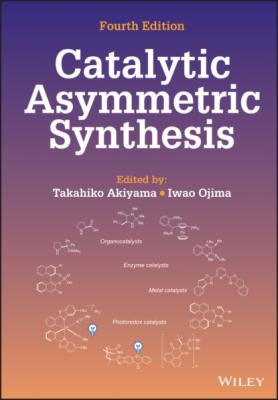Catalytic Asymmetric Synthesis. Группа авторов
Чтение книги онлайн.
Читать онлайн книгу Catalytic Asymmetric Synthesis - Группа авторов страница 63

As a pioneering study of chiral guanidine as a chiral Brønsted catalyst, in 1994, Nájera and co‐workers reported the enantioselective nitroaldol reaction albeit with only a modest enantioselectivity [56]. On the other hand, the first highly enantioselective reaction was reported by Lipton and co‐workers in 1996 [57]. They developed the enantioselective Strecker reaction catalyzed by chiral guanidine 21 (Scheme 3.31).
Scheme 3.31. Enantioselective Strecker reaction catalyzed by 21. Source: Based on [57].
In 1999, Corey and Grogan developed the enantioselective Strecker reaction catalyzed by chiral bicyclic guanidine 22a, which is the important seminal work in the field of chiral guanidine catalysis (Scheme 3.32) [58].
Scheme 3.32. Enantioselective Strecker reaction catalyzed by 22a.
Source: Based on [58].
In the report, the authors proposed the suggestive reaction mechanism (Figure 3.8). First, the deprotonation of hydrogen cyanide (HCN) by the guanidine proceeds to form the guanidinium cyanide complex. The complex can function as a hydrogen bond donor, and thus the activation of the imine electrophile occurs to form the pretransition‐state termolecular assembly. Finally, the attack of the cyanide within the ion pair to the hydrogen bond‐activated imine occurs to afford the adduct.
Figure 3.8. Proposed reaction mechanism.
Tan and co‐workers intensively studied the enantioselective transformations by using this type of chiral bicyclic guanidines 22, and successfully developed a lot of highly enantioselective reactions [59]. For instance, a series of enantioselective reactions of anthrones, such as the Diels‐Alder reaction with maleimide and the addition to Michael acceptors, was developed [60]. The tandem reaction process involving a Michael addition of thiols followed by a highly enantioselective protonation was also established by using tert‐butyl substituted 22b (Scheme 3.33) [61].
Scheme 3.33. Enantioselective protonation catalyzed by 22b.
Source: Based on [61].
Other remarkable application of chiral bicyclic guanidine 22b is the enantioselective synthesis of axially chiral allenoates by the enantioselective isomerization of 3‐alkynoates (Scheme 3.34) [62].
Scheme 3.34. Enantioselective isomerization of 3‐alkynoate catalyzed by 22b.
Source: [62].
Ishikawa and co‐workers developed chiral monocyclic guanidine 23 having a hydroxy group, and applied the catalyst to the enantioselective Michael addition of glycine imines to acrylates (Scheme 3.35) [63]. The control experiments suggested that the matched relative configuration of the three chiral centers on the catalyst and the existence of the hydroxy group are essential for achieving both high conversion and high enantioselectivity. The catalyst was also applied to the enantioselective oxa‐Michael addition for the synthesis of chromane skeletons [64].
Scheme 3.35. Enantioselective Michael addition of glycine imines to acrylates catalyzed by 23.
Source: [63].
Misaki, Sugimura, and co‐workers developed chiral bicyclic guanidine 24 bearing a hydroxy group as a hydrogen bond donor unit. This catalyst was highly effective in a series of enantioselective reactions of 5H‐oxazol‐4‐ones as a pronucleophile, such as direct aldol reaction and the 1,4‐addition to alkynyl carbonyl compounds (Scheme 3.36) [65].
Scheme 3.36. Enantioselective reactions of 5H‐oxazol‐4‐ones as a pronucleophile catalyzed by 24.
Source: [65].
Nagasawa and co‐workers developed a series of guanidine‐(thio)urea bifunctional catalysts 25 having conformationally flexible chiral linkers [66]. The catalyst design was based on the idea of using the formation of a double hydrogen bonding network, where a guanidine and a (thio)urea simultaneously activate a pronucleophile and an electrophile, respectively. The adequacy of the catalyst design was verified by applying them to a variety of enantioselective reactions. For instance, guanidine‐bisthiourea catalyst 25a was successfully utilized in the ortho‐selective alkylation of phenols through the enantioselective addition with nitroalkenes (Scheme 3.37) [67].
Scheme 3.37. Enantioselective addition of phenols to nitroalkenes catalyzed by 25a.
Source: Based on [67].
On the other hand, the use of guanidine‐bisthiourea catalyst 25b enabled the solvent‐dependent enantiodivergent Mannich‐type reaction (Scheme 3.38) [68]. The authors concluded that the origin of solvent‐dependent stereodiscrimination was controlled by the enthalpy–entropy